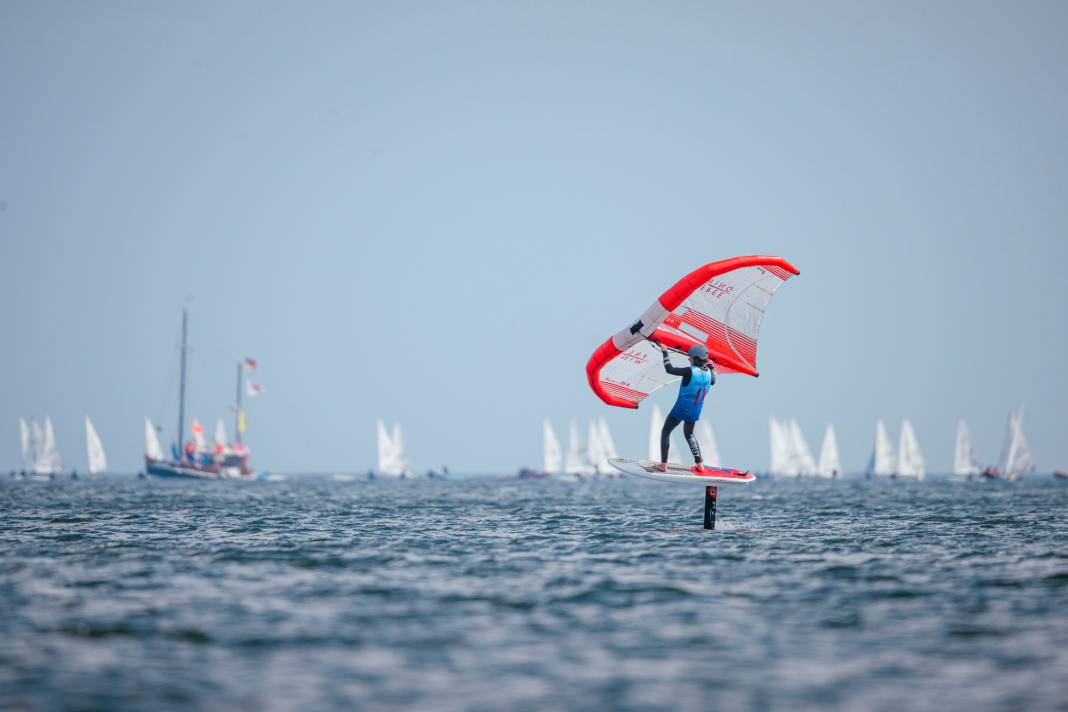Kieler Woche: Wingfoiling is a trend sport that can't be stopped by seaweed






A sunny Kiel Week morning in the Schilksee harbour apron: 16 pairs of eyes and ears are focused on Fiona Wylde and her team. The final briefings on the regatta programme are on the agenda. The 27-year-old, multiple world champion in stand-up paddling (SUP) and expert in wingfoiling, gives practical and tactical tips and explains the flag signals and rules.
The audience is young and in some cases inexperienced in regattas - and yet they are all ambassadors for a new discipline at Kieler Woche. Wingfoiling will be integrated into the regatta week with a demo and coaching event on X-15 boards. The U19 athletes have been practising and training diligently since Thursday to now take to the regatta course. Perhaps this will be an anticipation of the future, in which wingfoiling is flirting with Olympic status. The class is already delivering spectacular races, with athletes reaching speeds of over 35 knots.
"Kiel Week is ideally prepared to organise major foiling events"
Three groups went through the training days - from absolute beginners to advanced and experts. While the beginners were still new to handling the board on its underwater wings and the portable wing sail, the boys and girls with their first experience were already able to lift the board out of the water in phases. And the experts were already flying impressively fast and safely over the water with the six square metre wing sail. They all made further leaps in their development. "It was great. Two of the beginners started foiling on the very first day," reports Wylde. She is enthusiastic about the opportunities offered to the young sport at Kieler Woche: "It's great to be part of this event. All the Kieler Woche organisers are friendly and courteous to us and have given us a warm welcome. The co-operation with the regatta management runs smoothly."
Kieler Woche also spares no effort to prepare the field for wingfoiling. This also included collecting the seaweed in Strander Bucht. "We didn't have too much seaweed on our course, but the positive effect was noticeable. Afterwards, the course was easy to sail," says Wylde and promotes Kiel as a location for wingfoilers, but also for iQFoil surfing and kiting: "Kieler Woche is perfectly prepared to organise large foiling events."
The praise is balm to the soul of the regatta organisation under the direction of Dirk Ramhorst. "We want to get the Olympic disciplines iQFoil and Formula Kite, which have been cancelled this year, excited about Kieler Woche," says the man from Dänischenhagen, "which is why we are also tackling this natural problem, sustainably of course."
Seaweed in the Baltic Sea: "SeeKuh I" clears the regatta course
Dealing with the fauna and flora of the Baltic Sea is a fundamental topic for water sports enthusiasts and Kiel Week. And seagrass is in the spotlight for good reason. Because the seagrass meadows in the Baltic Sea make a major contribution to carbon sequestration and are therefore an important factor in climate protection.
However, seaweed torn off by storms and waves is an unloved obstacle for active sailors during regattas. On the Baltic Sea, which is sometimes exaggeratedly referred to as a flooded seagrass meadow, fields of torn-off plants are a regular occurrence. These stalks, which can wrap themselves around the underwater wings, are a particular problem for foiling surf and kite classes. But floating seaweed also has a value. And so Kieler Woche makes a virtue out of necessity and has the "SeeKuh I" collection vessel fish out the seaweed in Strander Bucht in order to reuse it.
Microbiologist Rüdiger Stöhr from the One Earth - One Ocean association holds thick bundles of seaweed in his hand on board: the yield after a day of collecting off Schilksee. "I was amazed at how well we were able to collect the seaweed," says Stöhr. Over ten kilograms, or around a bricklayer's tub full of seaweed, ended up on the ship, which was built in Lübeck in 2016 as a waste collection vessel. After a short time in Hong Kong, it is now in service in the Baltic Sea. The follow-up ship, the "SeeKuh 2", now collects waste in Manila and has been further developed with conveyor belt technology. The "SeeKuh" is a 12 x 10 metre catamaran with a net that can be stretched between its hulls. The objects floating on the surface of the sea are hoisted on board. In the meantime, the ship is to be improved for further missions. The focus is on ghost nets, i.e. fishing nets that have been lost. A diving platform has been installed for this purpose. A compressor and a new engine should provide more options.
Sustainability: Seagrass that is problematic for sailors can be further processed
But the first Kiel Week day on the water in terms of seaweed has also shown: The "SeeKuh" can also do this job. "The seaweed appears in a kind of road that is very easy to collect. We will refine the campaign at the weekend by sending out a kind of scout on the motorboat to look for these seaweed roads for us," explains Rüdiger Stöhr.
The marine biologist was not really aware of the seagrass problem for regatta sport, but immediately found the task exciting when the question came up. There was another area of application here. Because the collected seaweed can be reused. Dried and processed, it is ideal as an insulating material in house construction or can be used as a natural filling material in cushions and blankets. Stöhr wants to test this possibility himself. The use of the "SeeKuh" at Kieler Woche could therefore be a win-win situation for athletes, house builders and others.

